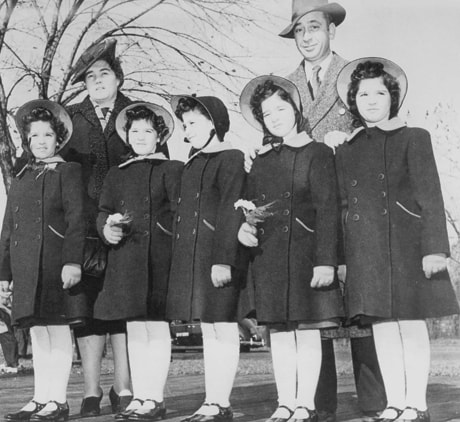TORONTO — They were hailed as medical miracles just by virtue of their survival as the world’s first-known living quintuplets, but the triumph of the Dionne sisters’ births would ultimately be overshadowed by tragedy.
Removed from their family home, they were made wards of the state and would spend the first nine years of their lives on display to millions of gawking tourists in a specially built hospital called “Quintland.” The Depression-era attraction in northern Ontario became a more popular tourist draw than Niagara Falls, and generated millions of dollars for government and local businesses.
In 1998, surviving sisters Annette, Cecile and Yvonne (who died in 2001) and their families received a $4-million settlement from the Ontario government for their mistreatment in childhood.
But the damage had been done. The trauma of their unorthodox upbringing in the public eye led to lives of closely guarded privacy when they grew up.
It has been 75 years since the births of the world-famous quints, but the ongoing public fascination with multiples has shown no signs of waning.
And not unlike the Dionnes, the high-profile coverage of modern-day multiples has raised fresh questions around placing children in the spotlight, and whether some families are seeking to capitalize on the novelty for a shot at fame or financial gain.
The Dionnes themselves addressed these concerns when they reached out to Bobbi and Kenny McCaughey following the birth of the couple’s septuplets in 1997 to offer advice about raising multiple-birth kids.
“We hope your children receive more respect than we did. Their fate should be no different from that of other children,” Annette, Cecile and Yvonne Dionne wrote in an open letter published in Time magazine. “Multiple births should not be confused with entertainment, nor should they be an opportunity to sell products.”
California mom Nadya Suleman, who gave birth to octuplets in January, invited media outlets to film her babies at home and at the hospital, and reportedly sought financial compensation for interviews.
One recent media report said lawyers have filed trademark applications on Suleman’s behalf for her media-anointed nickname “Octomom” for use on a TV show, as well as diapers, dresses, pants and shirts.
The hit TLC reality series Jon and Kate Plus 8, which follows a couple raising eight-year-old twins and five-year-old sextuplets, has captivated fans who tune in to the watch virtually every aspect of their private lives, including potty training, birthday parties and family outings.
Public interest in Jon and Kate Gosselin and their brood has been heightened in recent weeks with tabloid reports they have cheated on each other — allegations both deny. But the popular series has made celebrities out of the Gosselins and significantly boosted their bottom line.
The family lives in a US$1.3-million home, and they’re reportedly paid tens of thousands of dollars per episode. Kate makes paid speaking engagements, and has written two books about life with multiples.
Jon even acknowledged in the Season 5 premiere aired Monday that while they had originally done the show to document their children’s lives, “it’s become a business, just like anything else.”
But the show has also sparked criticism by some who are concerned about the possible impact on the children. Online petitions have called for boycotts of sponsors as well as for TLC to yank the series altogether.
A TLC publicity director told The Canadian Press in an email that the Gosselins are currently not doing interviews.
“The way that (the Dionnes) expressed how they feel about their past and how it defined their whole existence, how are we to know that 20 years from now that children who have been put in the limelight by their parents . . . who’s to say that those children aren’t going to feel the same way as the Dionnes?” said Gail Moore, chair of Multiple Births Canada.
“That’s what that letter, when they sent it to the McCaugheys, that’s what they’re trying to say — think about the children.”
Moore said in the case of the Gosselins, the series is only a representation of one aspect of life with multiple birth children, and isn’t necessarily a reflection of the challenges other families face.
“You have people that are watching the show thinking ‘How cute,’ and they’re not looking at what the reality is — that that family was lucky enough to have healthy children,” she said from New Liskeard, Ont.
“In their situation they’re lucky, because they don’t really have any special needs that take away from the family dynamic, but that’s what people are seeing; that’s what people are thinking it’s like to have a multiple birth family, and that’s not the reality for a lot of multiple birth families.”
University of British Columbia psychiatry professor Kerry Jang, who runs the largest study of adult twins in Canada, said part of the public fascination around multiples likely stems from people wanting to know where they came from and why they act the way they do.
“When you see it in twins, and especially in multiple births, it’s sort of like nature’s experiment,” said Jang, who is also a Vancouver city councillor. “It gives you insight into yourself, and I think that’s where it comes from, that fascination.”
Jang said while there is an understanding that families raising a large number of children need financial resources — and putting their life on display is one way of getting the help — he is more concerned about privacy issues.
“It is a fine line. I think some of these people because they do need the resources, so by getting on TV, you can get those diapers. But at what point does the need for the help go too far where it simply becomes profitable?”
